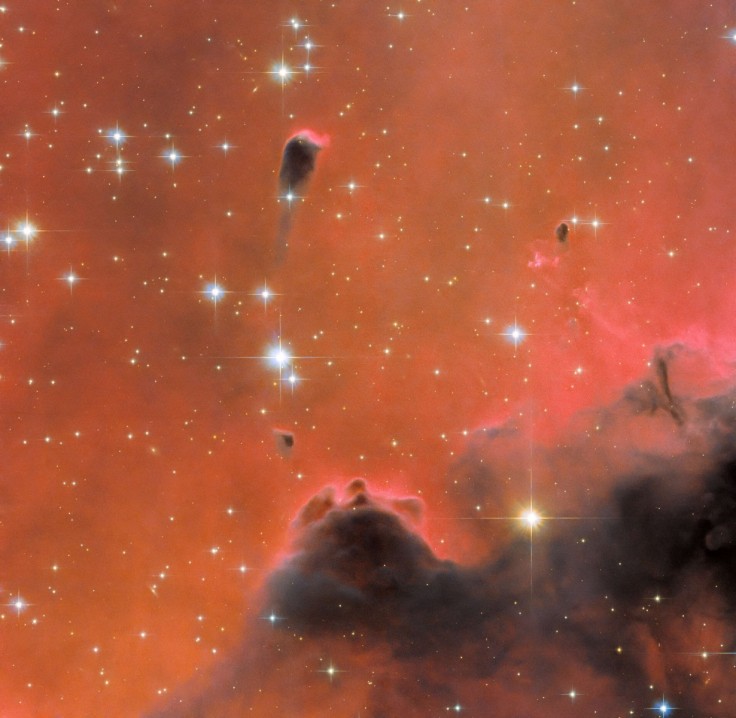The holidays aren't over for the Hubble Space Telescope.
The space observatory captured a rare image of the Soul Nebula glowing holiday red in time for the 2022 Holiday season, along with its Evaporating Gaseous Globule (frEGG).
Experts believe that Hubble will re-enter Earth's atmosphere to be retired from active service come the mid to late 2030s at the earliest, giving them ample time to capitalize on the space observatory's capabilities before that happens, per NASA.

Hubble Soul Nebula Picture Details
Hubble took a picture of the Soul Nebula, formally known as Westerhout 5, on Dec. 23, 2022, during the year's holiday season. The picture Hubble took is filled with a bright red light, along with a variety of interesting features, such as a free-floating Evaporating Gaseous Globule (frEGG), per the European Space Agency.
The red in the picture is created by a particular type of light emission known as H-alpha emission, which occurs when a very energetic electron within a hydrogen atom loses a set amount of energy.
This loss of energy causes the electron to become less energetic, making it release a distinctive red light.
The red light also helped reveal a frEGG by the nebula, which appears on the picture's upper-center left area as a dark, tadpole-shaped region.
According to Space.com, experts officially named this frEGG as KAG2008 globule 13 and J025838.6+604259.
Read More : Uber Eats' 'View As Delivery Person' Lets Users Select Which Personal Details To Show Couriers
FrEGGS are a particular class of Evaporating Gaseous Globules (EGGs). Both FrEGGs and EGGs are sufficiently dense regions of gas that "photoevaporate" less easily than the less compact gas around them.
Photoevaporation occurs when an intense radiation source like young, hot stars ionizes and disperses gas, releasing huge amounts of ultraviolet light.

You may know one famous example of an EGG that experts identified fairly recently, the tips of the Pillars of Creation, which Hubble took on Apr. 1, 1995, per NASA's Hubble Site.
FreGGS, on the other hand, are more discovered more recently, with experts finding them distinct from EGGS because they are separated from the gas surroundings them, creating their distinct tadpole-like shape.
Interestingly, the Soul Nebula is the partner of another nebula associated with a fast-approaching annual festival, the Heart Nebula, more formally known as IC 1805. Experts gave the nebula its name due to the glowing hydrogen content making it resemble a pink heart.
Hubble Space Telescope Details
![e Image Shows Incredible Look at Galaxies Doing Tug-of-War! [PHOTO]](https://d.itechpost.com/en/full/101990/e-image-shows-incredible-look-galaxies-doing-tug-war-photo.jpg?w=736&f=386fe70df676fe2ee97bf206e691e44f)
Hubble is quite an experienced and well-traveled space observatory. It first launched on Apr. 24, 1990, from the Space Shuttle Discovery and was deployed the day after, per NASA. As such, the telescope has been in operation for almost 33 years.
Its first picture wasn't as gorgeous as the ones it takes now. When it was first put into orbit, astronomers found a spherical aberration on the space observatory's 7.9-foot-wide main mirror.
Fortunately, NASA fixed the problem by installing other instruments that helped Hubble take pictures more clearly in 1993, and since then, it has been blowing scientists' minds with glimpses of our solar system and the universe at large.
Unfortunately, the Earth's gravitational pull is taking Hubble closer to Earth. Experts believe that come the mid to late 2030s, Hubble will eventually slip into the planet and retire in a blaze of glory.
However, it is up to experts if Hubble should be boosted up to its original orbit or if it should do a controlled reentry into the South Pacific.
Related Article : Hubble Space Telescope Spots a Cosmic Keyhole, the NGC 1999









